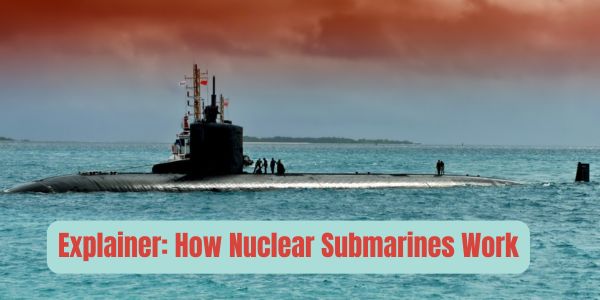Nuclear submarines are marvels of modern engineering, capable of operating underwater for months at a time without resurfacing. Powered by nuclear reactors, these vessels are critical to naval defense and strategic operations for many nations. This explainer breaks down how nuclear submarines function, their key components, and their role in global security.
What is a Nuclear Submarine?
A nuclear submarine is a military vessel that uses a nuclear reactor as its primary power source. Unlike diesel-electric submarines, which rely on batteries and frequent surfacing to recharge, nuclear submarines can remain submerged for extended periods—often limited only by food supplies for the crew. They are used for missions like strategic deterrence, intelligence gathering, and anti-submarine warfare.
How Does a Nuclear Submarine Work?
The heart of a nuclear submarine is its nuclear reactor, which generates heat through nuclear fission. Here’s a step-by-step look at the process:
- Nuclear Reactor: The reactor splits uranium atoms in a controlled chain reaction, releasing heat energy. This process is highly efficient, requiring only a small amount of fuel (often less than 100 pounds of enriched uranium) to power the submarine for decades.
- Heat to Steam: The heat from the reactor is transferred to a coolant (usually water), which circulates through a closed loop. This coolant heats water in a secondary system, creating high-pressure steam.
- Steam Turbine: The steam drives turbines, which are connected to generators and the submarine’s propulsion system. The turbines convert thermal energy into mechanical energy, spinning the propeller to move the submarine.
- Electricity Generation: Excess energy from the turbines powers onboard systems, including navigation, communication, and life support. This eliminates the need for separate power sources.
- Condensation and Recycling: After passing through the turbines, the steam is cooled and condensed back into water, which is recycled into the steam generator, creating a closed system.
The reactor operates continuously, providing a steady power supply. This allows nuclear submarines to travel at high speeds (up to 30 knots or more) and remain submerged for months, typically 90 days or longer, depending on crew provisions.
Must Read: What Are Hypersonic Glide Vehicles, and How Do They Differ from Traditional Ballistic Missiles?
Key Components of a Nuclear Submarine
- Reactor Compartment: Houses the nuclear reactor, heavily shielded to protect the crew from radiation.
- Propulsion System: Includes the propeller, shaft, and turbines for movement.
- Sonar and Sensors: Advanced sonar systems detect other vessels and underwater obstacles, crucial for navigation and combat.
- Weapons Systems: Nuclear submarines carry torpedoes, cruise missiles, and, in some cases, ballistic missiles for strategic deterrence (e.g., U.S. Ohio-class or Russian Borei-class submarines).
- Life Support Systems: Oxygen generators and carbon dioxide scrubbers maintain a breathable environment, while desalination plants provide fresh water.
Types of Nuclear Submarines
- Attack Submarines (SSN): Designed for hunting enemy submarines and ships, intelligence gathering, and special operations support. Example: U.S. Virginia-class.
- Ballistic Missile Submarines (SSBN): Carry nuclear-armed ballistic missiles for strategic deterrence. Example: U.K. Vanguard-class.
- Cruise Missile Submarines (SSGN): Equipped with guided missiles for precision strikes. Example: Modified U.S. Ohio-class.
Must Read: How Have International Treaties Attempted to Limit Ballistic Missile Proliferation?
Advantages of Nuclear Submarines
- Endurance: Can operate for months without refueling or resurfacing.
- Speed and Stealth: High speeds and quiet operation make them hard to detect.
- Global Reach: Capable of deploying anywhere in the world’s oceans.
- Strategic Deterrence: SSBNs provide a survivable second-strike capability, deterring nuclear aggression.
Challenges and Risks
- High Costs: Building and maintaining nuclear submarines is expensive, often costing billions per vessel.
- Nuclear Safety: While reactors are designed with multiple safety systems, accidents or malfunctions could have severe consequences.
- Environmental Concerns: Disposal of nuclear waste and decommissioning reactors pose long-term challenges.
- Geopolitical Tensions: The deployment of nuclear submarines, especially SSBNs, can escalate international rivalries.
The Role in Global Security
Nuclear submarines are a cornerstone of naval power for countries like the United States, Russia, China, France, and the United Kingdom. They project power, deter adversaries, and maintain a balance of power on the global stage. For example, the U.S. and its allies rely on SSBNs as part of their nuclear triad, ensuring a credible response to any nuclear threat.
Recent developments, such as the AUKUS pact (Australia, U.K., U.S.), highlight the growing importance of nuclear submarines. Under this agreement, Australia will acquire nuclear-powered submarines, boosting its naval capabilities in the Indo-Pacific region.
Looking Ahead
Advancements in reactor technology, stealth, and weaponry continue to evolve nuclear submarines. Future designs may incorporate smaller, more efficient reactors and enhanced automation to reduce crew sizes. However, as more nations pursue nuclear submarine programs, debates over proliferation and arms control are likely to intensify.
Nuclear submarines represent a unique blend of cutting-edge science and strategic necessity. Their ability to operate undetected for months makes them one of the most formidable tools in modern warfare, shaping the balance of power beneath the waves.

